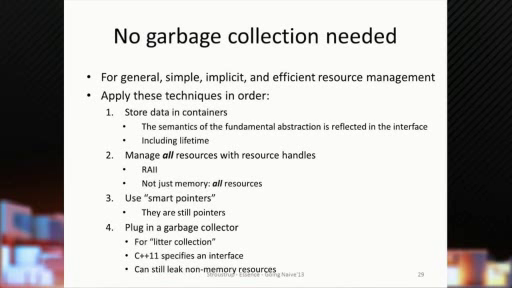以下幻灯片来自 Bjarne Stroustrups 的演讲“C++ 的本质”:

我是否通过以下简单示例(值、原始指针、资源成员/子对象的智能指针)理解了他的技术?:
1.
class foo{
std::vector<bar> subObj;
int n;
public:
foo(int n) : n(n) {
subObj.push_back(bar("snickers"));
}
};
2.
class foo{
std::vector<bar>* subObj;
int n;
public:
foo(int n) : n(n){
subObj = new std::vector<bar>();
subObj->push_back(bar("snickers"));
}
~foo() {
delete subObj;
}
};
3.
class foo{
std::unique_ptr<std::vector<bar> > subObj;
int n;
public:
foo(int n) : n(n){
subObj(new std::vector<bar>());
subObj->push_back(bar("snickers"));
}
};
为什么 1. 优于 2.?如果我实例化一个 foo 对象并取消引用它以获取小 n 成员的值,那么 vector 成员也将被加载到内存中,对吗?有了2,只有指针被加载到内存中!对于这个问题,我想假设 vector 在执行期间会有些大。
此外,为什么 2 (RAII) 优于智能指针?开销不是很相似吗(都在生命周期后销毁资源)?
最佳答案
无论 2 是什么,它都不比任何东西更可取。当您复制一个 foo 对象时,这是一个等待发生的意外。
Why is 1. preferable over 2.? If I instantiate a foo object and dereference it in order to get the value of the small n member, the vector member will be loaded into memory as well, right? With 2, only the pointer is loaded into memory!
这很令人困惑——这里的所有内容都已经在内存中了,那么你到底要加载到内存中的是什么?确实2中的foo比1中的foo小,所以你可以在同一个cache line中放更多的foo,当您在不接触 vector 的情况下对 foo 数组进行操作时,可能会产生更好的性能。
但是 vector 本身只不过是三个指针(用于开始、结束、容量),所以它并不是一个巨大的位置损失。 vector 的内容可以任意大(当然有一个限制),但它们在其他地方。当您实际需要使用 vector 时,foo 的较小尺寸带来的微小位置增益很可能会被额外的间接级别消除。
关于c++ - 是什么激发了 Stroustrup 对资源管理技术的偏好顺序?,我们在Stack Overflow上找到一个类似的问题: https://stackoverflow.com/questions/29179809/